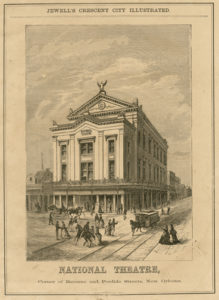National Theatre
The National Theatre, built in 1866 on the corner of Baronne and Perdido Streets in New Orleans, was an important music venue in the city during the late nineteenth century.

Courtesy of The Historic New Orleans Collection
National Theatre. Thiel, William (Architect)
The National Theatre, built in 1866 on the corner of Baronne and Perdido Streets in New Orleans, was an important music venue in the city during the late nineteenth century. Constructed by prominent members of the city’s then-thriving German community, it functioned as a venue for German theatrical productions and was often referred to as the Deutsches Theater. In 1880 the theater changed hands, and the new owner—piano and music vendor Philip Werlein, the son of a German immigrant—renamed it Werlein Hall.
Architect William Thiel designed the National Theatre’s elegant structure. The ground level contained commercial space, while the theatre itself began on the second floor and contained four levels of seating. With a capacity of approximately 1,500, the venue was considerably larger than nearby competitor Grunewald Hall, which was owned by another German American music vendor, Louis Grunewald. According to newspaper accounts, the boxes were draped luxuriously with painted silk to match the stage curtain, and the theater was lit by eighty gilded candelabras. The ceilings were frescoed and a round dome provided ventilation. Fire safety was ensured through numerous exit doors, wide hallways, and water storage containers on the upper levels.
German productions had been staged in New Orleans as early as 1839, but, following a fire that destroyed the first German Theatre on Magazine and Delord Streets in 1855, the German community had no home stage. The National Theatre filled this role. Its musical contributions to New Orleans were numerous, including the city’s first full-length productions of Mozart’s The Magic Flute and Beethoven’s Fidelio.
By the mid-1870s, however, the National Theatre was no longer solely a venue for German-language productions and was sometimes referred to by different names, including the Globe Theatre or the Bijou Theater. When Werlein purchased it in 1880, the theater had lost the reputation for elegance and sophisticated performance it had enjoyed when it was the National Theatre. At one point its license had been revoked by the city due to lewd performances. Werlein insisted that it was “devoted only to the most refined and respectable amusements.” These included performances by the German singing societies of the time, such as Liedertafel, the New Orleanser Quartett Club, and Frohsinn. After Werlein purchased and renamed the theater in 1880, it operated as a for-hire venue with no regular seasons.
The building burned to the ground on July 2, 1887, in a fire that started in an upholstery business that occupied part of the building’s first level. Le Pavillon Hotel now occupies the site on Poydras Street.
